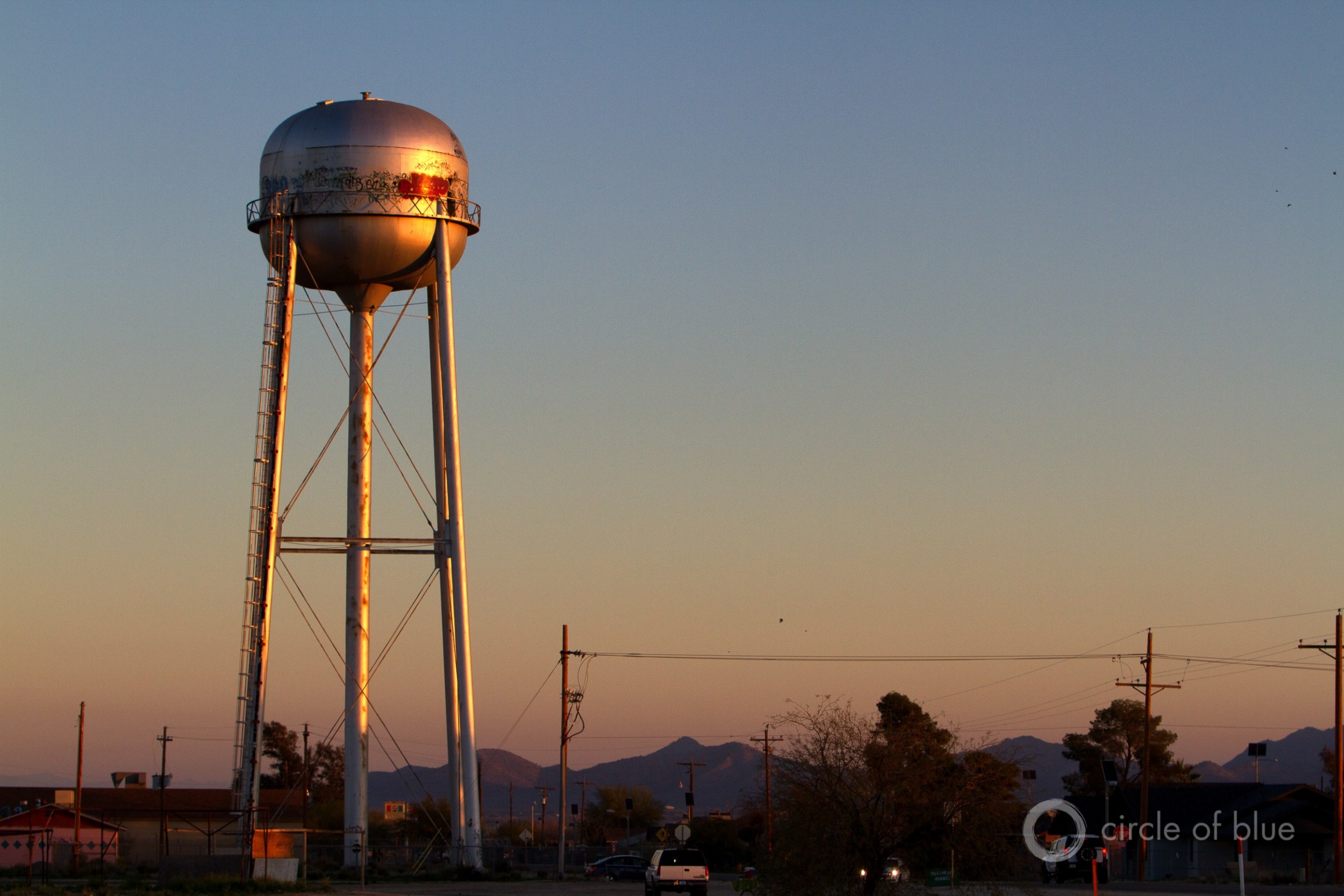Landmark law encounters new problems, enduring challenges.

A water tower in Sacaton, the central town of the Gila River Indian Community. Photo © J. Carl Ganter / Circle of Blue
By Brett Walton, Circle of Blue – December 16, 2024
The American public, newly conditioned to the health dangers of a polluted environment, was worried.
Media reports documented carcinogens in the lower Mississippi River. The federal government, empowered by recent legislation, sued Reserve Mining Company for dumping asbestos-like fibers into Lake Superior, thereby jeopardizing the water supply for Duluth, Minnesota, and at least four other communities. Congress had just approved groundbreaking laws for cleaner air and ecosystems. What about tap water?
Those were the circumstances in 1974 as a receptive Congress and a supportive-but-cost-conscious Ford administration debated first-ever national drinking water standards.
In the previous four years, lawmakers had passed the Clean Air Act and the Clean Water Act. “Nothing is more essential to the life of every single American than clean air, pure food, and safe water,” Russell Train, then-administrator of the Environmental Protection Agency, wrote to President Gerald Ford. “The time is overdue for a Safe Drinking Water Act.”
Fifty years ago, on December 16, 1974, Ford clinched a public health victory when he signed a bill that joined the pantheon of federal environmental protection laws enacted that decade.
Today, the country still reaps the benefits. Most Americans are provided high-quality water from their taps.
“At a time when the American public is skeptical of the government’s ability to take positive action and improve their lives, the Safe Drinking Water Act is an example of the essential work that our government can and must do to stand up for our well-being,” Radhika Fox, assistant administrator for water at the U.S. Environmental Protection Agency from 2021 to 2024 told a Senate committee last month. “It’s a demonstration of the most basic mission of our government: to safeguard the rights and interests of its people.”
As the Safe Drinking Water Act begins its next half century, it is clear that the law is an essential piece of the country’s project to assure every American access to safe, reliable, affordable water. But there is still much room for improvement. By one estimate, some two million people in the country do not have running water or indoor plumbing at home. Black and Hispanic communities, especially if they are poor, are more likely to have low quality drinking water. The struggles of small water systems that serve dozens or hundreds of people remain problems.
The act was weakened in 2005, following secret meetings between the oil industry and the Bush administration, that advanced oil and gas development by exempting chemical fluids used in fracking from federal oversight.
There are also elements of drinking water provision that the act does not explicitly address. Aging infrastructure, a changing climate, decaying plumbing within buildings, and limited funding for repairs are major impediments. Private well water is not regulated.
Health and environmental groups, seeing the proliferation of chemicals in commerce and their links to cancer, kidney disease, and other chronic ailments, encourage the U.S. Environmental Protection Agency (EPA) to regulate more of these contaminants.
The agency appears to be paying attention. It decided earlier this year to set national standards for six PFAS – the persistent and toxic “forever” chemicals used in non-stick, water-repellent goods and firefighting foams. They were the first additions to the roster of regulated contaminants in decades. Perchlorate, used in explosives and a concern for fetal brain development, is next on the EPA agenda, due to a court order.
A counter argument – offered most passionately by public policy experts and utility leaders – is that the EPA is focusing on the wrong risks. This line of thinking suggests that regulators are targeting new chemical contaminants when they should be more concerned about the reliability of the pipes through which water flows. Utilities and municipalities have limited funds, the argument goes, so the biggest health risks should be addressed first.
Pipe breaks – which occur by the hundreds every day in this country – can pull pathogens into water systems and do immediate harm. Plumbing systems inside buildings, which are not regulated by the Safe Drinking Water Act, can harbor Legionella bacteria, which causes Legionnaires’ disease, a respiratory illness that is the country’s deadliest waterborne disease. It kills about one in 10 people it infects. A Legionnaires’ outbreak in Grand Rapids, Minnesota, that began in 2023 sent 11 people to the hospital.
Chad Seidel, president of Corona Environmental Consulting, worries that the failure to invest in basic infrastructure will result in less reliable water systems that are prone to malfunctioning and spreading disease. Backsliding on infrastructure quality would be detrimental, he said.
“I believe the health risks of regressing are higher than the risk of unregulated contaminants,” Seidel said.
The data show that certain water providers have higher risks of failure. In 1970, the EPA’s drinking water division assessed the quality of water from 969 systems. Most failing systems were small.
So it is today. Small water systems, a half century later, are more likely to violate health standards and monitoring requirements.
The country counts about 50,000 public water systems, most of them small. Many lack the financial strength or managerial know-how to successfully operate. There is a growing consensus that small systems will need to be absorbed into larger neighbors, or form regional entities that take advantage of scale to provide better service.
Amendments to the act in 1996 established a revolving loan fund that is the federal government’s primary vehicle for financing local drinking water improvements. Despite tens of billions of dollars added to the fund in the last three decades, state and local governments still account for about 95 percent of water infrastructure spending. Utility leaders fret that Congress is starting to erode the revolving fund by extracting earmarks from its annual appropriation. In time, this will result in less money available to lend.
“You can’t talk about the future of safe drinking water without talking about how to pay for it,” said Rob Greer, who studies public administration at Texas A&M University.
Water utilities are lobbying for a federal program to assist low-income people with their water bills, as the government does for energy bills. During the pandemic, Congress approved a short-term water bill assistance program but it has expired. A federal program would allow utilities to raise rates to pay for needed repairs, while not burdening their poorest customers with large bills.
Even if adequate funding is secured, there are social and cultural headwinds buffeting utilities. An unknown but rising number of people do not drink their tap water. They do not trust it.
Mistrust is highest among Black and Hispanic communities who are also most likely to have tap water that exceeds federal standards or looks and tastes gross. Notorious tap water failures in Flint, Michigan, and Jackson, Mississippi, in the last decade highlight the ease by which trust can be lost.
Mistrust is illustrated by soaring sales of bottled water and the growing presence of commercial water kiosks, a trend documented by Samantha Zuhlke of the University of Iowa and Manny Teodoro of the University of Wisconsin-Madison. Both bottled water and kiosk water have less regulatory scrutiny than tap water.
Water is an intimate relationship between individuals and their government because water is the “only government service you ingest,” Teodoro said.
Brett writes about agriculture, energy, infrastructure, and the politics and economics of water in the United States. He also writes the Federal Water Tap, Circle of Blue’s weekly digest of U.S. government water news. He is the winner of two Society of Environmental Journalists reporting awards, one of the top honors in American environmental journalism: first place for explanatory reporting for a series on septic system pollution in the United States(2016) and third place for beat reporting in a small market (2014). He received the Sierra Club’s Distinguished Service Award in 2018. Brett lives in Seattle, where he hikes the mountains and bakes pies. Contact Brett Walton





